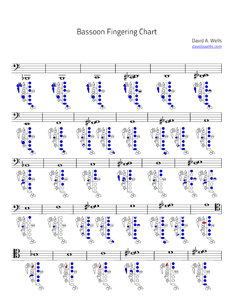Update (6/25/2014): Find the latest version of my fingering charts here: https://davidawells.com/resources/fingering-charts/

My favorite fingering. No, really…
A couple of weeks ago, I started teaching a high school violist who decided that she’d like to play the bassoon. Not knowing if she’d gotten her hands on a fingering chart or not, I decided to take one to her lesson. I have quite a few charts lying around, but as I looked through them, I realized that I didn’t completely agree with any of them, at least not for use by a beginning student. I ended up taking her a copy of a chart that I’d gotten from the Conn-Selmer web site, but only after I’d marked it all up with a pen. It turned out that she did have a fingering chart already, but I didn’t completely agree with it, either. As I was driving home from her first lesson, I thought to myself how silly it is to give a student a fingering chart that I’ve marked all over, especially since this certainly isn’t the first time I’ve done so. I resolved then and there that I’d make my own fingering chart.
Awhile ago, I’d come across the very cool and well-thought-out Fingering Diagram Builder built by Bret Pimentel, multiple-woodwinds teacher at Delta State University. (You can read more about the FDB here). But until now, I hadn’t done any more than just play around with it. I used Bret’s FDB to crank out an image for each of my basic fingerings. I included my most common alternate fingerings, but didn’t get into slur, muted, trill, or other variations.
Once I had all of the images, I had to decide how best to lay them out within a score. I’ve been using Finale for years, but I’d recently started playing around with LilyPond. LilyPond is an open-source music engraving program that produces very nice-looking scores — far closer in appearance to good old-fashioned hand engraving than Finale’s often jagged and weirdly-spaced output. The downside (if you choose to see it that way) is that LilyPond has no graphical user interface; it generates scores from specially formatted text files, and is in that way more like a programming language than a traditional notation program. But, I’d been looking for a project to undertake with LilyPond, and this seemed like just the thing.
It took awhile to get the hang of LilyPond, and some formatting things I only ever got by trial and error. But, I finally ended up with two versions of my personal fingering chart. The first is the one I’ll hand students. It covers the more-or-less standard range of the bassoon (Bb1 — E5), uses only bass and tenor clefs, and includes a diagram with key names. The second, which I’ve dubbed my “Pro” chart, discards the key diagram and switches to treble clef at the top end. Oh, it also goes up to Bb5 (although I don’t yet have a reliable fingering for A5 — anybody?).
Since Bret has made the diagrams generated by his FDB available under a Creative Commons Attribution-NonCommercial-ShareAlike 3.0 Unported (CC BY-NC-SA 3.0) license, I’ve done the same with my charts. Please, take a look and let me know what you think. Is there anything I could do to make them easier to read, easier to use, or just plain look nicer? Or do you spot any fingerings that I’ve rendered incorrectly?

